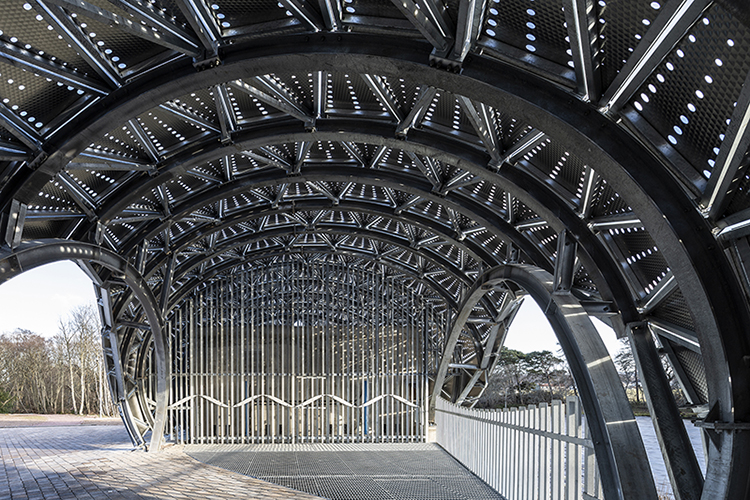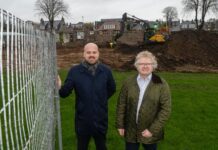
TRIMBLE’S constructible BIM software has been hailed as playing a key role on the River Ness Hydroelectric generation project.
Featuring a ‘striking’ canopy structure, the project has been described as both a ‘geometrically complex build’ and also an important part of the local infrastructure.
Located on the banks of the River Ness, the Hydro Ness project aims to generate a clean source of energy for the Highland Council. The structure houses a 93kW hydroelectric power twin turbine, which will generate an estimated 550,000 kWh every year.
A steel canopy structure was designed to house the generators, with the initial design concept created by local artist Claire Maclean, before being developed further by Inverness architect Les Hutt. Working on behalf of project developer and main contractor, Hydro NI – Bradley & Company JV, the canopy geometry definition, structural design, detailing, and fabrication model development was completed by Hasson Engineering Solutions.
The roof canopy design was inspired by the shape of a diving salmon, a fish commonly found in the River Ness. As such, some form of texture was needed to create the illusion of ‘scales’. It was decided to achieve this through the use of thousands of circular perforations and polished swirls in the 386 faceted stainless steel cladding panels that made up the canopy structure.

Michael Hasson, director at Hasson Engineering Solutions, said, “The Hydro Ness project had a high architectural value, requiring an integrated approach to the structural and architectural design. Geometrically complex, the roof canopy structure curved on different axes. For us, it was all about finding the balance between being respectful of Claire’s original design concept and delivering a high-impact look, worthy of its location beside the banks of the beautiful River Ness; all while being capable of safe and efficient fabrication and erection – quite the challenge!”
When it came to detailing each of the faceted cladding panels and the thousands of perforations required to achieve the design brief, it became clear that this would have been an extremely time-consuming process, if done manually.
Michael added, “As a result, we decided that it would be a more efficient use of our time and resources to create custom components within the Tekla Structures software, specifically written to automate the definition and execution of countless perforations in the cladding panels. This was a process of using a defined algorithm to consider, analyse and interrogate each facet and proportions with a rule set; allowing for parametric definition of the perforations and full control of their size, number, and distribution within every panel.
“This unsurprisingly saved us a huge amount of time. The Tekla Structures software really is limitless in terms of its geometric capabilities – while it’s great for routine detailing jobs, the software is very powerful indeed when you need to go up a few gears.”
BIM software was also said to be ‘fundamental’ to the success of the detailing and fabrication of the steel frame and stainless steel cladding panels, with four major openings and the roof canopy’s curved form all having to be rationalised in Tekla Structures. The geometry was achieved by modelling the curved ‘ribs’ on a curved grid pattern, with each prism-shaped cladding panel then fixing to the primary roof structure. The ability to define blended circular and elliptical forms was described as ‘absolutely essential’, thanks to the geometric capabilities of the 3D modelling software.
Given the complexity of the project, a high-level of communication was required to be maintained between all parties. Michael explained, “Trimble Connect is a software tool that’s going from strength-to-strength and is ideal for facilitating effective coordination and collaboration. No matter where everyone was, it was as if we were all in the same room together. More specifically, as an engineer and detailer, the transparency enabled by the software is especially powerful. It made it possible for me to easily and visually present all my reasoning and the decision-making process behind each choice, as well as showing a great level of detail – right down to the individual fixings and fabrication details.
“At the end of the day, someone has to fabricate the structure that we’ve designed and engineered, and so communicating and providing a clear design intent is critical. As engineers, we have to take and deliver true responsibility in giving fabricators a finished product. Tekla Structures enables you to create and deliver a fabrication-ready model; a model that the fabricator can then work off of with minimal further input or tweaking.
“When it comes to architecturally and geometrically complex projects, such as the Hydro Ness, BIM is essential.You are able to clearly express your design intent in a visual and highly detailed manner, as well as demonstrate the buildability of the structure.
“Not having to wrestle with 2D drawings to achieve such a complex 3D form, and making use of parametric capabilities and custom components, frees up more of your time and thinking for other things; being able to focus more on how to make the structure as easy as possible to fabricate and as safe as possible to erect on site.”
The Hydro Ness is now completed and generating clean energy, as well as providing an architectural landmark. The project has won numerous awards, including Small Project in the UK Tekla Awards, Small Project of the Year in the British Construction Industry Awards (BCIA 2022), Scottish Highlands & Islands Renewable Energy Award for Best Onshore Renewable Energy Project 2022 and was also commended with a Merit at the Structural Steel Design Awards 2022.









